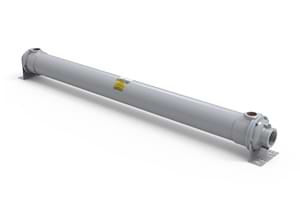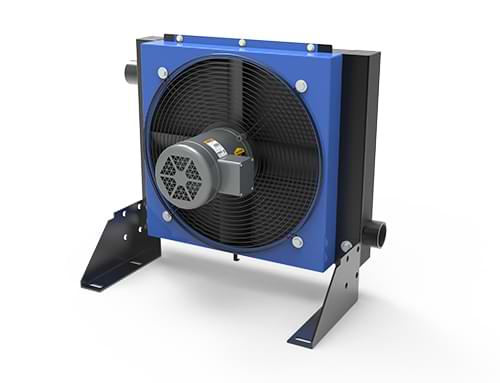Reciprocating Compressor Aftercoolers
Reciprocating compressors, often called piston compressors due to their piston-driven design, compress air through a back-and-forth motion within a cylinder. Aftercoolers are installed downstream of these machines to cool the hot, compressed air before it enters storage or distribution systems, providing several key advantages.
- Features: Our high performance aftercoolers are available in a full line of sizes and features. Their high performance, energy efficient design will make removing water from your air easy.
- Flow Rates: We offer units capable of a large range of compressed air flow rates, from less than 20 SCFM up to 3,500 SCFM.
- Design Pressures and Temperatures: Our standard units have operating pressures up to 300 PSI and operating temperatures up to 350 F, but we also offer custom designs beyond these limitations.
Water Cooled Aftercoolers
Compressor Cooling
- Fixed or Removable Tube Bundles
- Material Options Available
- Standard and Custom Options

Air Cooled Aftercoolers
Compressor Cooling
- Use Ambient Air to Cool
- Variety of Motor Options
- Standard Pressures of Up To 250 psi

One primary benefit for reciprocating compressor users is moisture removal. As air is compressed in a reciprocating system, its temperature rises significantly—often exceeding 200°F (93°C). This hot air carries a high moisture content, which can condense into liquid water as it cools in pipes or equipment, leading to corrosion, rust, or damage to tools and processes. Aftercoolers rapidly lower the air temperature, causing water vapor to condense and separate before it can cause harm. This is especially critical for reciprocating compressors, which tend to produce hotter discharge air compared to other designs, due to their intermittent compression cycles.
Another advantage is improved efficiency and equipment protection. The high heat generated by reciprocating compressors can strain downstream components like dryers, filters, and receivers. By cooling the air, aftercoolers reduce thermal stress, extending the lifespan of these parts and ensuring consistent system performance. Additionally, cooler air is denser, allowing more air to be stored in a given volume, which optimizes the compressor's output—a boon for applications requiring steady pressure.
Now, regarding reciprocating and piston compressors: the terms are often interchangeable because both describe the same fundamental mechanism. A reciprocating compressor uses a piston moving within a cylinder to compress air, driven by a crankshaft. The "reciprocating" label emphasizes the piston's oscillating motion, while "piston" highlights the key component. There’s no functional difference—both operate with the same start-stop cycles, distinguishing them from continuous-flow designs like rotary screw compressors. However, some might argue "reciprocating" is a broader category, potentially encompassing rare non-piston variants, though in practice, piston-based systems dominate.
For reciprocating compressor users, aftercoolers are indispensable. They mitigate the heat and moisture challenges inherent to the design, ensuring cleaner, cooler air for industrial tasks like powering pneumatic tools or spray painting, while safeguarding the system itself. This tailored cooling solution aligns perfectly with the demands of piston-driven compression.


